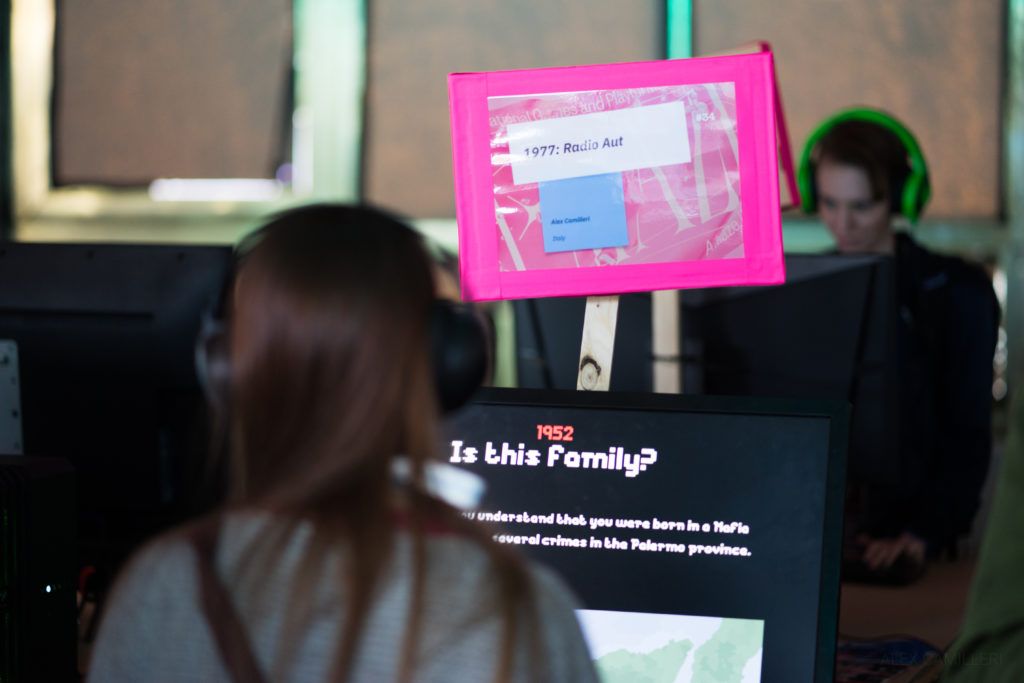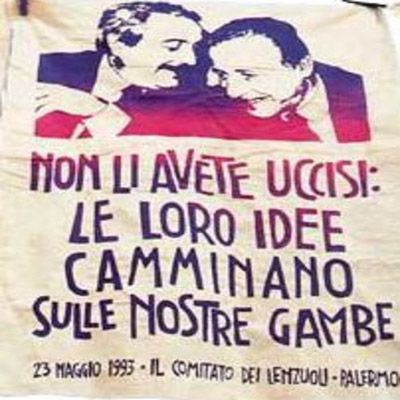Anti-mafia with 1977: Radio Aut
On the 40th anniversary of Peppino Impastato's death, I write some form of post-mortem of my short game 1977: Radio Aut.

Today is the 40th anniversary of Peppino Impastato’s death. His bravery and history are deeply inspirational to me and many others. He opposed Sicilian mafia and gave his life to follow his moral principles in a time when fighting it was unthinkable.
Few months ago, during the Global Game Jam 2018, I’ve made a short interactive story in tribute to his story. It’s called 1977: Radio Aut and you can play it here for free.
After some interviews and many questions about this project, I’ve decided to write a blog post about it, explaining what pushed me to make it and what were the design principles behind it. I will talk about some specific parts of the game, so I’d advise you to play the game before you keep reading.
The catalyst
I left Sicily almost 8 years ago. Since then I’ve met tons of amazing people from different cultures and backgrounds. While making new friends has always been a great experience, I’ve continuously suffered (and still do) from the way many people approach my origins. The introduction often goes like this:
“Where are you from?”
“I’m from Palermo, in Sicily”
“Oh, so you’re with Mafia!” / “Oh, Cosa Nostra!” / “Oh, so we gotta be careful!”
You might be smiling right now, that’s not your fault! Being subject to this follow-up hurts every single time, to the point where I question whether I should say where I am from. I eventually (and obviously) do, I just need to put a smile on my face and change topic quickly. The reason why this sucks so much is obvious to Italian people; we know the tragic effects that Mafia had on too many innocent citizens and, in a broader sense, on the well-being of our country. If you are not Italian and you have not been interested in the topic, it’s quite likely that you’ve been exposed to the romanticized view of Sicilian mafia as depicted by gangster movies. So I think it is not necessarily your fault if you think that making mafia jokes (especially to a Sicilian person) is funny.
Historically, mainstream media have done a pretty poor job at showing the tragic history of mafia and, to be fair, it is somewhat common in Sicily to see – especially in very touristic places – souvenir shops using mafia-related items to make some easy money.
But hey, not everything is lost! Games are my medium and I feel like it is my responsibility to help fixing something that I find broken. 1977: Radio Aut won’t make a big difference, but knowing that my work can help people abroad exploring Sicilian history and understanding the gravity of some words is a first step in that direction, I hope. In this post I will go through the process of developing 1977: Radio Aut, explaining in details different aspects of this complex but brief creative journey.
Making of: Pillars
For the longest time I’ve had the desire to make a historically accurate game about mafia. Considering how mafia dates back all the way to 1800, it’s always been difficult for me to pinpoint a time-frame to focus on. On top of this, I’ve always seen this as a potential big dream project. I’ve done many prototypes and written down tons of material in the attempt to figure out how to make a game about such a delicate topic. As stupid as it might sound, it feels incredibly intimidating to put such a responsibility on your shoulders, especially when you are still relatively young and there’s people who studied and researched the phenomenon for decades. Because of this extremely high level of complexity and pressure, I’ve always shied away from making the leap and properly push a specific project forward. Too much history, too much suffering and not enough balls to get started anywhere. “What if I do it in an insensitive way?”. “What if the message doesn’t go through?”. “What if I never get to finish it”? Typical gamedev questions, but all of this has always been 10 times amplified in my brain because of how connected I feel to this topic.
When the Global Game Jam started and the theme was revealed (“transmission”), I immediately thought of Radio Aut, the local radio that Peppino Impastato and other brave young Sicilians used to transmit their anti-mafia message in Sicily. A gamejam game about mafia! The idea of adopting the complete opposite approach to what I’ve always had in mind felt immediately exciting to me: rather than thinking of a gran plan for a big project, what if I can actually be extremely focused on one single but significant story? Can this be the key to overcome this subconscious fear and finally make the leap forward?

At this point I was convinced: “I will make a game about Radio Aut and its anti-mafia message”. But as a game designer it is important to understand why you want to do specific things, what the final goal is, and how you plan to make the experience engaging. This led to the main big question: “Why would anyone outside of Italy care?”. The answer: “They most likely won’t.”. I think that they won’t because they don’t have a context to understand Radio Aut and its role in Sicilian history. They don’t know mafia nor anti-mafia (they are not part of their identity) and they most likely won’t feel interested enough. The question now becomes “How can I make them care?”. I grounded all my design decisions around three pillars.
1st Pillar: 10-15 minutes playtime
It is unrealistic to expect a person that knows nothing about the topic to invest a long time exploring Sicilian history. Every narrative/gameplay decision needs to serve this purpose.
But how can such a short experience leave a mark on the player? Can the player really understand and care about Radio Aut and anti-mafia? Once again, I felt like this was not achievable and I had to find a different way to frame the experience. This is when the main shift in terms of narrative scope happened. “I won’t talk exclusively about Radio Aut, but I will focus on Peppino Impastato.”. It is much more efficient, in my opinion, to nurture a sense of empathy towards a person compared to a more abstract concept.
2nd Pillar: narration in second person
My target audience doesn’t know who Peppino Impastato is and my goal is to establish a strong sense of empathy towards him by the end of the experience. Because of this, it is much more powerful to identify the player and Peppino. “You are Peppino”.
At this point I am confident that I have strong enough tools to create a connection between the player and Peppino. But to make this connection even stronger, I feel like I can’t just focus exclusively on the time when he was spreading anti-mafia messages at Radio Aut. Because of this problem, the final change involves the overall narrative arc. I will now go from life to death; from the very beginning to the very end.
3rd Pillar: historical accuracy
This is the most difficult challenge. I cannot be respectful to Peppino’s history if I twist events or if I am not accurate. It is fundamental that by the end of the game the player has the tools to understand that what they played is a true story.
I can’t stress enough how much time has been spent “outside” of the technical development itself. The majority of the focus ended up on reading, writing, watching and listening to research material. Peppino’s story is now well-known in Italy, but a lot of details are not super easy to find. Luckily the website of Centro Impastato (an amazing organization that takes care of keeping together all the facts and documentation relative to Peppino’s life) allowed me to have access to the best possible sources of information to make sure everything was correct. I’ve obviously taken a bit of artistic freedom to present the story in an interesting way, but all the facts are accurate. On top of this, all the audio clips are original clips from Radio Aut. Most people won’t understand them but it was important for me to make sure Peppino’s identity could emerge through the game. Even many of the illustrations are drown on top of existing photographs.

Making of: Narration and Player Agency
I ended up with a huuuuuge list of events and dates that could be part of the story. In order to be true to the 1st pillar, though, I had to identify what was important to keep the story powerful and relatable. Going over every single event I would ask myself:
“Is this a key moment in Peppino’s life?”
“Can this moment contribute to strengthen the player’s empathy towards Peppino?”
Events that didn’t fit in those two categories were left out. I then started implementing section after section in chronological order. Key aspect for me, though, was to understand if the overall narration felt good and had a nice flow. There were a couple of occasions in which I felt like the jump between two dates was too sudden, or a specific character appeared too abruptly. In those cases I went back to the list of events, figured out which ones I could use to fill these narrative gaps, and then included those new parts.
The other big structural question was connected, once again, to the 1st pillar. “How can I make sure that the player is engaged with the narration and they are not just going through a bunch of static slides?”. Up until that point, in fact, the game could have worked as a PowerPoint presentation. Not good! The immediate thought was to have some form of branching narrative, but this went against the 3rd pillar: Peppino’s story is a very specific one and I want the game to be as accurate as possible. Because of this, I don’t want the player to take different decisions than the ones Peppino took. But how do I solve this agency problem then? My approach to this was slightly experimental:
“I don’t want the choice system to provide actual choices. I want the choice system to support emotions and historical context.”
In this sense, 1977: Radio Aut is entirely based on the illusion of choice. Giving to the player the feeling that they can shape the story, but instead giving them a linear narrative with a branching structure that serves spocific emotions and enriches the historical context. I will give two examples to explain what I am talking about:
At one point in the game, Peppino is suddenly attacked and grabbed from behind. The game offers two choices: “Scream” and “Escape”. The player at this point got used to selecting one of the two options, but this time around if they try and move to the Escape option, the cursor doesn’t move. This is, obviously, because Peppino is blocked and can’t really escape even though he wants to. The choice system evokes this specific feeling to the player by subverting its normal behavior.
For what concerns the historical context, there are branches that give the player extra information and details about the environment that Peppino lived in. For instance, the player can join one of two meetups, one organized by the feminist collective, or another organized by the theater group. By picking one of the two the player will be exposed to information about how students organized events and movements during the 70s.
Expanding on the historical context, I realized that in order to make the player truly understand how unthinkable it was to speak-up against mafia I had to emphasize the culture of omertà. I did this by exploring the concept of silence and by making the player’s call for help useless.
Making of: Ending
Once the overall structure was in place, the biggest challenge became wrapping up the story in a strong and powerful way. “How can I make sure that the player finishes the game and feels moved?”. “How can I make sure the player finally understands the impact of Peppino’s actions?”.
To answer these two questions I followed two approaches.
-
Brutal truth
The ending of the game is quite violent. It is not graphical, but the terms used, the interactions and the overall tempo build up to the very final moment of Peppino’s life. I first got exposed to this approach by reading 40 Years of Mafia by Stefano Lodato. In the book, Lodato uses a deeply descriptive language, cold, brutal. While this makes it tougher to experience, it also removes the linguistic filters that keep us distant from the atrocious events that are rooted in the history of Sicily. I remember finding myself crying while reading that book several times, just because of the superb use of language. I felt like this was the right approach to make the player understand the pain that mafia brought to many innocent people. -
Post-Peppino & Anti-Mafia
In 1993, after two Italian anti-mafia prosecutors – Giovanni Falcone and Paolo Borsellino – were killed, Sicilian people went on the streets to protest, demand help from the State and give each other strength in the attempt to fight against mafia. One famous banner said “You did not kill them: their ideas walk on our legs.”. As I mentioned at the beginning of this blog post, my goal with 1977: Radio Aut was to show the tragic history of Sicily and explain to people that are not familiar with our history how important anti-mafia is to our culture. To serve this purpose and give a full resolution to Peppino’s history, I decided I would make a final sequence that went from his death in 1978 to today, 40 years later. The main tool I used to support this unexpected shift, is the deliberate break from the 2nd person narration, shifting to 3rd person. During the ending sequence, an audio clip from Radio Aut starts playing again, supporting the idea that Peppino’s message is still alive to this very day, 40 years after his tragic death.

That’s it! It was a small but deeply complex project. Probably one of the most complex games I’ve made from a conceptual perspective. Thanks for reading all the way to this point, I hope this was interesting to understand a bit more about the project, the design decisions I took, and what drove me to making this short interactive story. I think it will take us a long time to escape from the rude stereotypes and avoid the silly jokes, but the only way to move forward is to spread more information about Sicilian history and or identity.
